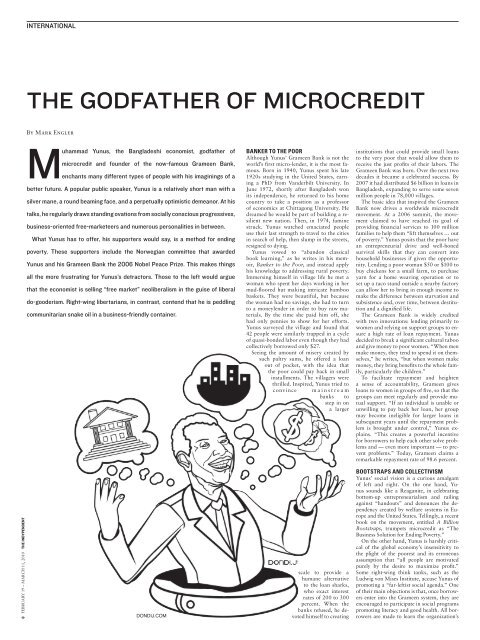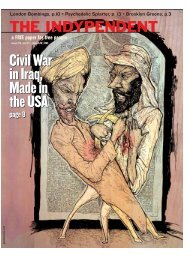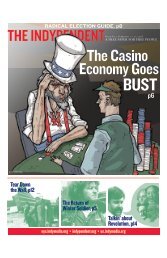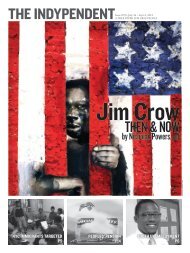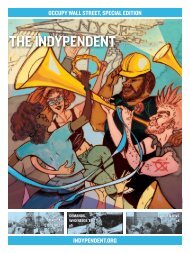Download Issue (pdf) - The Indypendent
Download Issue (pdf) - The Indypendent
Download Issue (pdf) - The Indypendent
You also want an ePaper? Increase the reach of your titles
YUMPU automatically turns print PDFs into web optimized ePapers that Google loves.
INTERNATIONAL<br />
<strong>The</strong> Godfather of Microcredit<br />
By Mark Engler<br />
Muhammad Yunus, the Bangladeshi economist, godfather of<br />
microcredit and founder of the now-famous Grameen Bank,<br />
enchants many different types of people with his imaginings of a<br />
better future. A popular public speaker, Yunus is a relatively short man with a<br />
silver mane, a round beaming face, and a perpetually optimistic demeanor. At his<br />
talks, he regularly draws standing ovations from socially conscious progressives,<br />
business-oriented free-marketeers and numerous personalities in between.<br />
What Yunus has to offer, his supporters would say, is a method for ending<br />
poverty. <strong>The</strong>se supporters include the Norwegian committee that awarded<br />
Yunus and his Grameen Bank the 2006 Nobel Peace Prize. This makes things<br />
all the more frustrating for Yunus’s detractors. Those to the left would argue<br />
that the economist is selling “free market” neoliberalism in the guise of liberal<br />
do-gooderism. Right-wing libertarians, in contrast, contend that he is peddling<br />
communitarian snake oil in a business-friendly container.<br />
BANKER TO THE POOR<br />
Although Yunus’ Grameen Bank is not the<br />
world’s first micro-lender, it is the most famous.<br />
Born in 1940, Yunus spent his late<br />
1920s studying in the United States, earning<br />
a PhD from Vanderbilt University. In<br />
June 1972, shortly after Bangladesh won<br />
its independence, he returned to his home<br />
country to take a position as a professor<br />
of economics at Chittagong University. He<br />
dreamed he would be part of building a resilient<br />
new nation. <strong>The</strong>n, in 1974, famine<br />
struck. Yunus watched emaciated people<br />
use their last strength to travel to the cities<br />
in search of help, then slump in the streets,<br />
resigned to dying.<br />
Yunus vowed to “abandon classical<br />
book learning,” as he writes in his memoir,<br />
Banker to the Poor, and instead apply<br />
his knowledge to addressing rural poverty.<br />
Immersing himself in village life he met a<br />
woman who spent her days working in her<br />
mud-floored hut making intricate bamboo<br />
baskets. <strong>The</strong>y were beautiful, but because<br />
the woman had no savings, she had to turn<br />
to a moneylender in order to buy raw materials.<br />
By the time she paid him off, she<br />
had only pennies to show for her efforts.<br />
Yunus surveyed the village and found that<br />
42 people were similarly trapped in a cycle<br />
of quasi-bonded labor even though they had<br />
collectively borrowed only $27.<br />
Seeing the amount of misery created by<br />
such paltry sums, he offered a loan<br />
out of pocket, with the idea that<br />
the poor could pay back in small<br />
installments. <strong>The</strong> villagers were<br />
thrilled. Inspired, Yunus tried to<br />
convince m a i n s t r e a m<br />
banks to<br />
step in on<br />
a larger<br />
institutions that could provide small loans<br />
to the very poor that would allow them to<br />
receive the just profits of their labors. <strong>The</strong><br />
Grameen Bank was born. Over the next two<br />
decades it became a celebrated success. By<br />
2007 it had distributed $6 billion in loans in<br />
Bangladesh, expanding to serve some seven<br />
million people in 78,000 villages.<br />
<strong>The</strong> basic idea that inspired the Grameen<br />
Bank now drives a worldwide microcredit<br />
movement. At a 2006 summit, the movement<br />
claimed to have reached its goal of<br />
providing financial services to 100 million<br />
families to help them “lift themselves … out<br />
of poverty.” Yunus posits that the poor have<br />
an entrepreneurial drive and well-honed<br />
survival skills that they can convert into<br />
household businesses if given the opportunity.<br />
Lending a poor woman $50 or $100 to<br />
buy chickens for a small farm, to purchase<br />
yarn for a home weaving operation or to<br />
set up a taco stand outside a nearby factory<br />
can allow her to bring in enough income to<br />
make the difference between starvation and<br />
subsistence and, over time, between destitution<br />
and a dignified life.<br />
<strong>The</strong> Grameen Bank is widely credited<br />
with two innovations: lending primarily to<br />
women and relying on support groups to ensure<br />
a high rate of loan repayment. Yunus<br />
decided to break a significant cultural taboo<br />
and give money to poor women. “When men<br />
make money, they tend to spend it on themselves,”<br />
he writes, “but when women make<br />
money, they bring benefits to the whole family,<br />
particularly the children.”<br />
To facilitate repayment and heighten<br />
a sense of accountability, Grameen gives<br />
loans to women in groups of five, so that the<br />
groups can meet regularly and provide mutual<br />
support. “If an individual is unable or<br />
unwilling to pay back her loan, her group<br />
may become ineligible for larger loans in<br />
subsequent years until the repayment problem<br />
is brought under control,” Yunus explains.<br />
“This creates a powerful incentive<br />
for borrowers to help each other solve problems<br />
and — even more important — to prevent<br />
problems.” Today, Grameen claims a<br />
remarkable repayment rate of 98.6 percent.<br />
8 February 19 – March 11, 2010 <strong>The</strong> <strong>Indypendent</strong><br />
dondij.com<br />
scale to provide a<br />
humane alternative<br />
to the loan sharks,<br />
who exact interest<br />
rates of 200 to 300<br />
percent. When the<br />
banks refused, he devoted<br />
himself to creating<br />
BOOTSTRAPS AND COLLECTIVISM<br />
Yunus’ social vision is a curious amalgam<br />
of left and right. On the one hand, Yunus<br />
sounds like a Reaganite, in celebrating<br />
bottom-up entrepreneurialism and railing<br />
against “handouts” and denounces the dependency<br />
created by welfare systems in Europe<br />
and the United States. Tellingly, a recent<br />
book on the movement, entitled A Billion<br />
Bootstraps, trumpets microcredit as “<strong>The</strong><br />
Business Solution for Ending Poverty.”<br />
On the other hand, Yunus is harshly critical<br />
of the global economy’s insensitivity to<br />
the plight of the poorest and its erroneous<br />
assumption that “all people are motivated<br />
purely by the desire to maximize profit.”<br />
Some right-wing think tanks, such as the<br />
Ludwig von Mises Institute, accuse Yunus of<br />
promoting a “far-leftist social agenda.” One<br />
of their main objections is that, once borrowers<br />
enter into the Grameen system, they are<br />
encouraged to participate in social programs<br />
promoting literacy and good health. All borrowers<br />
are made to learn the organization’s


